 |
>
>
> Active
Monitoring
|
|
Active Monitoring
Methods of active monitoring are standardised to an even higher degree as compared to passive biomonitoring:
The culture of selected plant species takes place under homogeneous and standardised conditions, e.g. in the greenhouse. After a given culture period, the plants are exposed under defined exposure conditions for a limited time (mostly several weeks) on the site.
Use of uniformely developed plants results in more precise information on the extent of air pollution impact and the time of its incidence. Additionally, the choice of the monitoring site is independent of the natural occurrence of certain plants, which is most important in urban or industrialized areas.
The most common methods in active biomonitoring are:
|
|
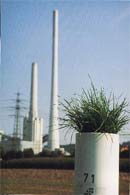 |
|
 Standardised Grass Culture (VDI 3957 / 2) for assessing the impact by inorganic sulfur, fluoride, chloride and metals, and also polychlorinated dioxins and furans (PCDD/PCDF). One of the major strenghts are the high resolution in time and space, which can be achieved by this method. Standardised Grass Culture (VDI 3957 / 2) for assessing the impact by inorganic sulfur, fluoride, chloride and metals, and also polychlorinated dioxins and furans (PCDD/PCDF). One of the major strenghts are the high resolution in time and space, which can be achieved by this method.
Standardized Grass Cultures of rye grass accumulates pollutants from the air
|
 |
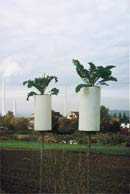 |
 |
 Curly Kale Exposure (VDI 3957 / 3) for assessing the impact of semivolatile organic compounds like polycyclic aromatic hydrocarbons (PAHs), polychlorinated biphenyls (PCBs) or polychlorinated dioxins und furans (PCDD/PCDF). Curly Kale Exposure (VDI 3957 / 3) for assessing the impact of semivolatile organic compounds like polycyclic aromatic hydrocarbons (PAHs), polychlorinated biphenyls (PCBs) or polychlorinated dioxins und furans (PCDD/PCDF).
The large, waxy leaf surface of curly kale favours the accumulation of organic air pollutants
|
|
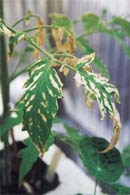
Solvent exhaust air, e.g. from from varnishing plants can cause clearly visible damage to tomato and nasturtium plants
|
|
 In some cases, no suitable bioindicators are available for the pollutant(s) of interest. In this case, a screening and selection procedure can be applied under semi-controlled conditions of appropriate pollutant stress. For example, a new combination of susceptible plants has been established and successfully applied (under known pollutant impact as well as under field conditions) in routine monitoring of air pollution by an organic solvent mixture from a large automotive plant. In some cases, no suitable bioindicators are available for the pollutant(s) of interest. In this case, a screening and selection procedure can be applied under semi-controlled conditions of appropriate pollutant stress. For example, a new combination of susceptible plants has been established and successfully applied (under known pollutant impact as well as under field conditions) in routine monitoring of air pollution by an organic solvent mixture from a large automotive plant.
|
|
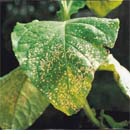
Selected tobacco varieties respond very sensitively to elevated ozone levels generated during the summer
/td>
| |
 As a sensitive indicator in active monitoring, the highly sensitive tobacco cultivar 'Bel W3' is used to assess vegetation effects of tropospheric ozone and other photooxidants (VDI-guideline 3957 / 6). Frequently, this highly sensitive species is combined with other sensitive plants (bush bean, clover, sting nettle) to form an array of indicator plants with differential sensitivities. The percentage of leaf area, damaged by the air pollutants, is the criterion of effect (endpoint) measured. As a sensitive indicator in active monitoring, the highly sensitive tobacco cultivar 'Bel W3' is used to assess vegetation effects of tropospheric ozone and other photooxidants (VDI-guideline 3957 / 6). Frequently, this highly sensitive species is combined with other sensitive plants (bush bean, clover, sting nettle) to form an array of indicator plants with differential sensitivities. The percentage of leaf area, damaged by the air pollutants, is the criterion of effect (endpoint) measured.
|
|
In most cases of active biomonitoring, indicator plants are repeatedly exposed and replaced, usually in 2- or 4-week intervals. Plants are always exposed in the same stage of development known to be most sensitive to pollutant impact. During the period from May through September, up to 11 intervals can be assessed consecutively which allows a resolution in time high enough to locate and identify potential pollution sources.
|
|
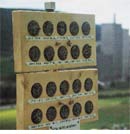
Acidic air pollutants cause visible damage to lichens and may result in complete die-back.
|
|
 The Standardised Lichen Exposure (VDI 3799 /2) employs the lichen species Hypogymnia physodes, which is exposed on pieces of tree bark, arranged on lichen boards. The percentage of visibly injured lichen thallus area is recorded after one year of exposure and serves as a unit of measurement, integrating over the effects of primarily acidic air pollutants. Beside visible in jury also accumulation of pollutants can be monitored in exposed lichens. Thus, lichens can be used as sensitive and accumulative bioindicators simultaneousl The Standardised Lichen Exposure (VDI 3799 /2) employs the lichen species Hypogymnia physodes, which is exposed on pieces of tree bark, arranged on lichen boards. The percentage of visibly injured lichen thallus area is recorded after one year of exposure and serves as a unit of measurement, integrating over the effects of primarily acidic air pollutants. Beside visible in jury also accumulation of pollutants can be monitored in exposed lichens. Thus, lichens can be used as sensitive and accumulative bioindicators simultaneousl
|